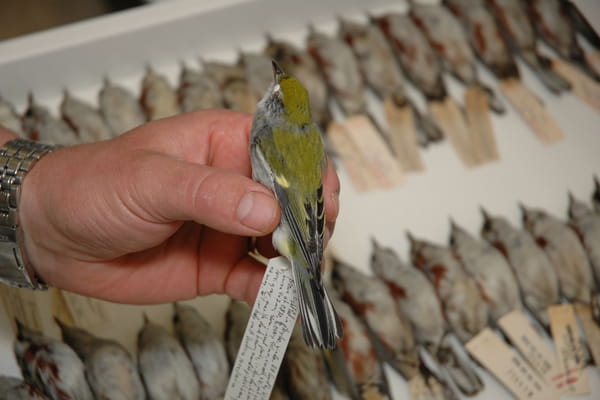'The Real Evidential Stuff': Students Explore Academy Collections in New Environmental Science Course

- Students, Faculty Represent Drexel University at COP28 Through Dialogue and Research
- STAR Summer Showcase Exhibits Advanced Research From 121 Undergraduate Students
- How Drexel's New Academic Resource Center (ARC) Will Be a Hub for Student Success
- Drexel Students, Research Community Made Their Mark on 2023 AAAS Meeting

Drexel’s revamped environmental science courses this past fall led students to the muddy marshes of New Jersey, a unique experiential learning opportunity resulting from the University’s affiliation with the Academy of Natural Sciences. Teaching science in the field rather than from a textbook provides a richer learning experience and is, in fact, the very motto of the new Biodiversity, Earth and Environmental Science (BEES) Department. A new course for freshmen this winter term, however, brings the focus back indoors and showcases one of the most fundamental components of biology and environmental science: natural history collections.
Twelve students have enrolled in ENVS 102: Natural History Collections and Research, a course that introduces them to the activity in the labs, library and archives and biological collection areas of the Academy. Led by professor and Academy scientist Dr. John Lundberg, students will explore the Academy’s collections of more than 18 million specimens collected from around the world over the past 200 years.
“Learning about natural history collections is about as basic as you can get,” said Lundberg, who has worked in the Academy’s ichthyology department for the past 12 years. “If one does not understand both the results of systematic research at the species level and above, and the methodology and the criteria for identification, there is just no way to do environmental science or any other kind of biology.”
These specimens are the material basis for what we know about life on earth. This is the real evidential stuff. - Dr. John Lundberg
In order for biology to make sense and be useful, he added, one really needs to have an evolutionary context, and that’s what the Academy’s collections represent. The students are definitely at an advantage, because the Academy is known for having one of the richest and largest collections of fishes, particularly South American freshwater and Caribbean marine fishes. The Academy is also home to one of the best diatom collections in the Americas and its malacology collection ranks among the very top collections in the world.
Over the next 10 weeks, students will explore each individual collection and learn how the specimens are used for research and the importance of preserving them.
“I hope they walk away with a general appreciation that they probably didn’t have before of how rich the collections are,” Lundberg said. “These specimens are the material basis for what we know about life on earth. This is the real evidential stuff.”
Lundberg added that he’ll stress this term that digitizing a specimen is not the answer for permanently preserving it. An unlimited amount of information can be extracted from physical specimens such as DNA, an animal’s diet, seasonal changes over time and information about environmental conditions at the time the specimen was preserved. Every specimen represents a moment in the history of our planet and there is simply no replacement for them, Lundberg said.
“The students will also learn how this material is used in research,” he said. “The Academy has hundreds of specimens collected over time. When you have that kind of information, you can piece together the history, and look at things like climate change, global warming and introduction of invasive species. If that’s not environmental science, I don’t know what is.”
Check in throughout the winter term to view guest blogs from students enrolled in the ENVS 102: Natural History Collection and Research course on the Drexel News Blog.
In This Article
Drexel News is produced by
University Marketing and Communications.